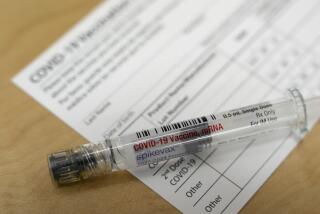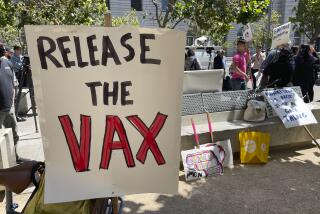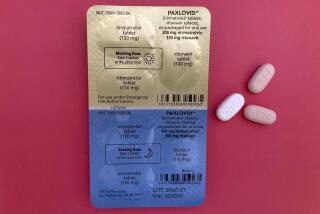Prognosis Uncertain for Next Season’s Supply of Flu Vaccine
- Share via
WASHINGTON — Federal regulators are planning a more measured approach to flu vaccinations for the 2005-06 flu season, telling lawmakers Wednesday it was too early to predict this year’s vaccine supply.
Progress has been made, they said, in fixing manufacturing problems at Chiron Corp.’s factory in Liverpool, England, where bacterial contamination forced the company to withdraw more than 50 million doses of the vaccine -- almost half the U.S. supply -- from the market last season.
Chiron has received British approval to produce the vaccine, but regulators told a congressional hearing that the company had not received a license to produce the vaccine for the U.S. market.
If it fails to do so, the United States could experience the same problems as last season, with 57 million doses of flu vaccine to distribute to those who need it most. Although 185 million people -- including the elderly, infants, and healthcare providers -- are designated as needing vaccine by the Centers for Disease Control and Prevention, the most shots they had requested was 83 million, federal regulators said.
“We will start the flu season with the high-risk people because we want the vaccine in their arms first,” said Dr. Julie L. Gerberding, CDC director. “If the vaccine comes through as expected, we’ll do the rest.”
Despite the shortage early in the season last year, immunization of high-risk people dipped slightly, she told the House Energy and Commerce subcommittee on oversight and investigations.
When vaccine doses did become available toward the end of the 2004-05 flu season, she said, the Department of Health and Human Services couldn’t get people to go for vaccinations.
“We can’t get people to get vaccines after Christmas,” said Gerberding, who noted that the flu season peaked in February.
Creating the influenza vaccine is a process that takes six to nine months, said Dr. Bruce Gellin, director of the National Vaccine Program Office. Each year, the vaccine has to be redesigned to include the strains of the virus that scientists expect to be most threatening.
“It would be ideal to have a vaccine that protects against multiple strains ... but the science isn’t there yet,” said Dr. Jesse Goodman, director of the Center for Biologics, Evaluation and Research at the Food and Drug Administration.
Researchers are looking for a vaccine that targets an aspect of the virus that is present in all strains of flu. Having such a vaccine could allay fears of a severe outbreak, such as the 1918 flu pandemic that killed an estimated 40 million people worldwide.
In the last 100 years, there have been three pandemics in the United States, Gerberding said.
More to Read
Sign up for Essential California
The most important California stories and recommendations in your inbox every morning.
You may occasionally receive promotional content from the Los Angeles Times.













